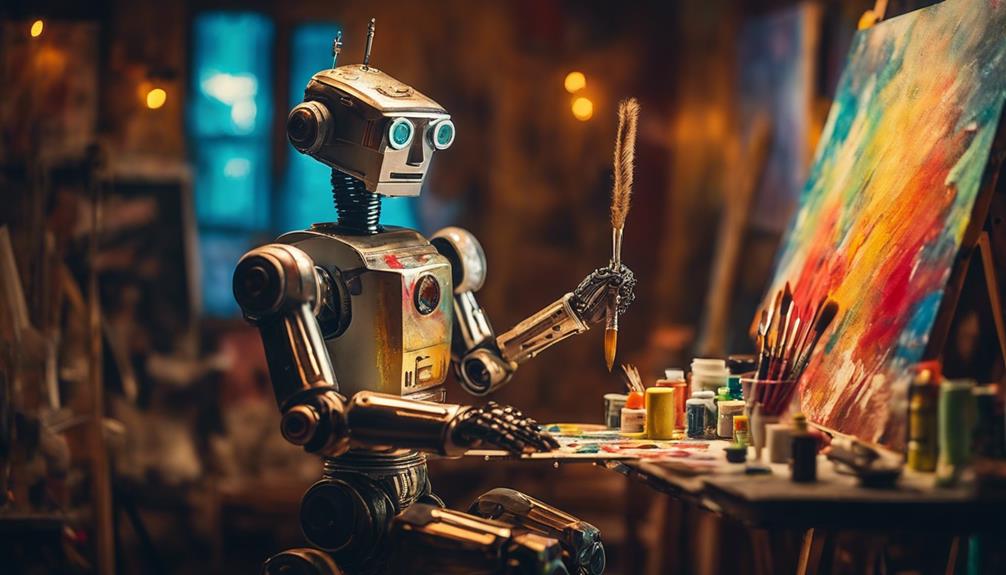Exploring Authorship in AI Art
The rise of AI-created visual art is transforming our understanding of what it means to be an artist. As artificial intelligence plays a more significant role in the art world, either by helping or even creating art on its own, we’re faced with new challenges. These include rethinking the laws around copyright, the ethical questions about machine-made art, and what artistry means.
This shift makes us question the relationship between human artists and AI in art-making. It’s an exciting time that could change how we view art in the digital era, sparking a broader conversation about creativity and authorship.
Key Takeaways
The emergence of AI-created visual art is shifting perceptions around artistic creation. As artificial intelligence becomes more involved in art production, we confront new legal and ethical dilemmas regarding copyright and the nature of creativity. This evolution prompts us to reconsider the dynamics between human artists and AI in crafting art. It’s a pivotal moment that could reshape our engagement with art in the digital age, igniting discussions on creativity and authorship.
Key Takeaways:
- AI involvement in art challenges existing copyright laws.
- Raises ethical questions on machine-generated creativity.
- Could redefine artistry in the digital landscape.
Defining AI Art
AI art merges technology with traditional art in a way that’s reshaping how we view creativity. Using algorithms, this art form allows artists to create visuals beyond what’s possible with human skills alone. It’s about the partnership between artists and artificial intelligence, opening new doors for what can be considered art.
The process is as significant as the artwork itself. Artists using AI find new ways to express themselves, combining the accuracy of machines with human creativity’s spontaneity. This mix challenges old ideas about who or what can be an artist. It’s making us rethink the role of technology in art, showing that AI can be more than just a tool; it can be a collaborator.
This shift is not just about making new kinds of art. It’s about starting conversations on how humans and machines interact in creative spaces. AI art is not just a niche; it’s becoming a vital part of the art world’s evolution, prompting discussions on the future of creativity and technology’s place in it.
The Algorithm as Artist
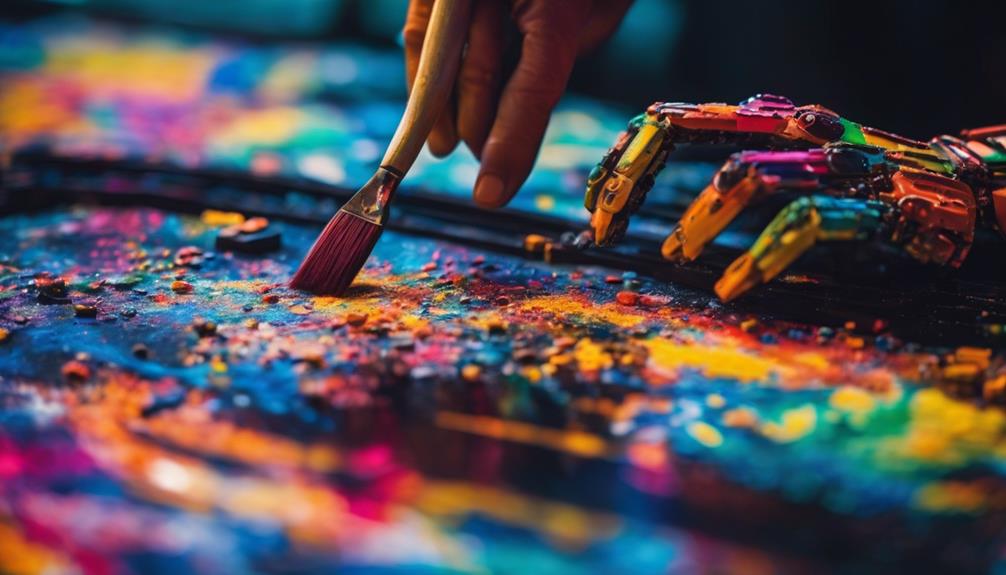
Venturing into AI-driven visual art, we see algorithms taking the spotlight, not just as tools but as the primary creators. This shift challenges our traditional views on who or what can be considered an artist. With algorithms at the helm, they’re not just assisting but leading the way in creating visual art. This marks a significant change, showing us the power of artificial intelligence. It’s not only about copying artistic methods but also about creating something new and different that makes us rethink who gets called an artist.
Algorithm as Artist: AI algorithms now decide art pieces’ look, feel, and subject matter with hardly any human help.
Creative Force: These algorithms prove that machine intelligence can stand independently as a creator in the art world.
Unique Outputs: Their art is so varied and original that it makes us question our old ideas of who creates art.
Technology Meets Creativity: This blending of algorithms and artistry shows how tech can do more than imitate creativity; it can add to it.
Redefining Authorship: With algorithms creating art, we’re forced to think about the human role in creativity and how the idea of being creative is changing.
This move to see algorithms as artists shows the intricate dance between technology and creativity. It pushes us to rethink our roles and reconsider what it means to be creative in the digital age.
Legal Landscape
The copyright laws around art made by AI are becoming more complex. This is especially true when trying to figure out who owns the art. The current laws are having difficulty dealing with the new issues that come with AI-made artworks. This leaves questions about who owns and has the rights to these works up in the air.
Regarding AI art, it’s tricky to understand who did what. The big question is whether AI should be seen as a creator, like a human, or a tool used to make art. This is important because it affects who gets the intellectual property rights.
The legal world is trying to find a way to deal with these challenges. They want to ensure that AI art is respected for its innovation while also protecting people’s rights. As laws change, figuring out the difference between a creator and a tool will be critical. This will shape how we see authorship in AI art moving forward.
Ethical Considerations
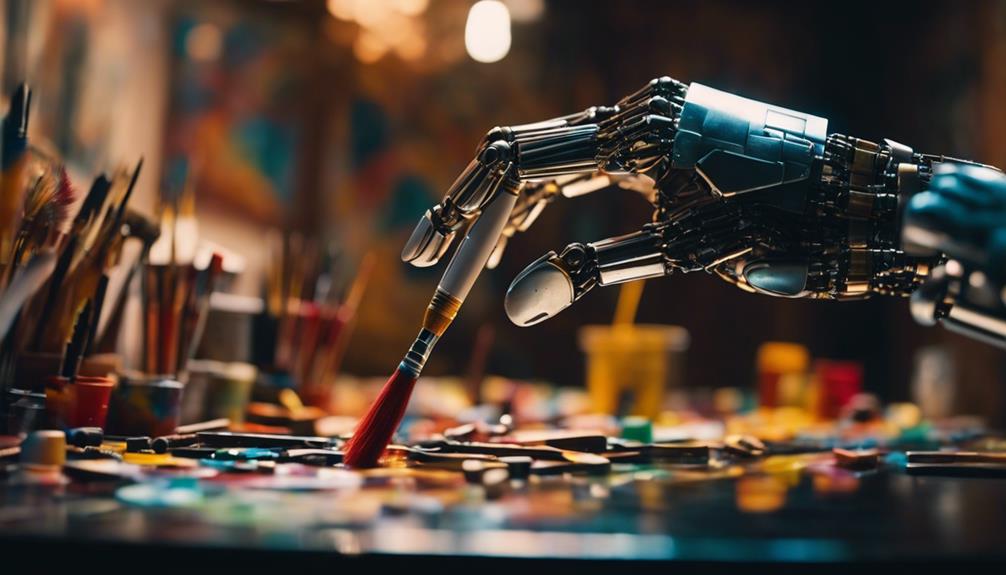
As we integrate AI into the creation of visual art, ethical questions emerge that involve how we define authorship, originality, and ownership. The use of AI in art blurs the lines between human and machine, prompting a need for careful consideration.
One major ethical issue is being transparent about AI’s role in art creation. It’s crucial to openly communicate how AI has contributed to a piece of art. This ensures everyone understands the extent of AI’s involvement.
Another aspect is acknowledging AI’s contribution to the creative process. This is about giving credit where it’s due, whether to the human artist, the AI, or both. It helps stakeholders understand the creative process better.
The uniqueness of AI-generated art raises questions about what makes art original or authentic. It’s a challenge to figure out whether AI can replicate or mimic human creativity.
Deciding who owns AI-created art is also complex. Is it the artist who used the AI, the developers who made the AI, or a combination of both? This critical question affects how we value and protect creative works.
Artists and developers must think deeply about these ethical issues. They must balance embracing new technology and respecting traditional artistic values. As the art world adapts to AI, it must do so responsibly, ensuring that technological advancements align with ethical standards and legal requirements.
Creative Process Reimagined
In visual art, the introduction of AI has dramatically changed how artists approach their work. These innovative tools allow creatives to blend their intuition with data analysis, opening up new avenues for artistic exploration. This isn’t just a step forward; it’s a new way of thinking about art. AI helps artists see patterns and ideas previously out of reach, pushing past old creative blocks easily.
The partnership between humans and AI in art is a game-changer. It’s not just about making the workflow easier; it’s about creating something entirely new. Artists are now using AI to explore areas of creativity that mix the logical with the imaginative, resulting in unprecedented artwork. This new approach is revolutionizing visual art, creating a rich field of unimaginable possibilities.
With AI’s input, artists are venturing into creative territories that fuse analytical thinking and artistic flair. This has opened up a world of artistic innovation that challenges and expands upon traditional views of what art can be. The result is a vibrant and evolving field of visual art that offers fresh perspectives and breaks new ground.
Ownership Debates
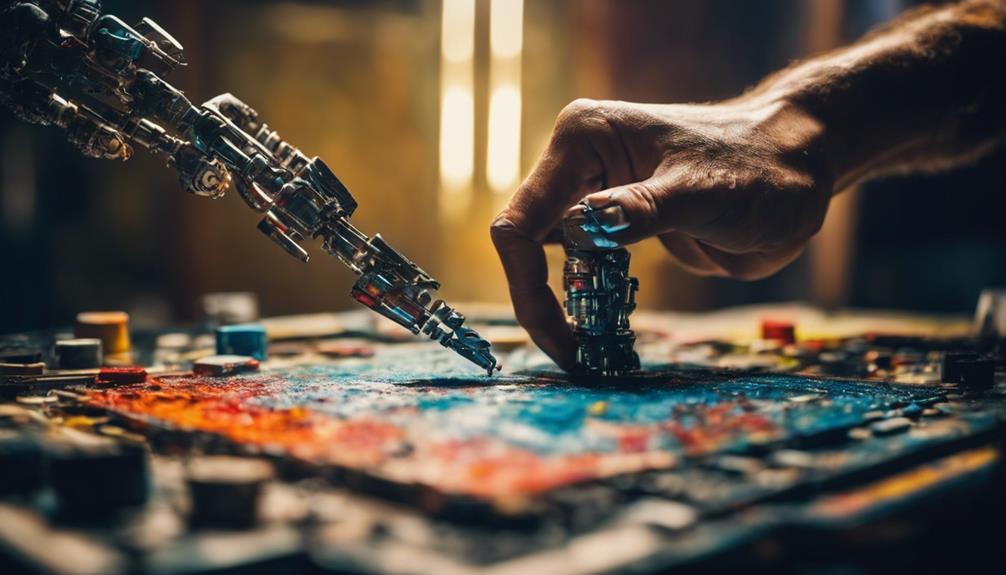
The ongoing debates about who owns AI-created visual art highlight a tricky area in law and ethics. Figuring out if we should view AI as a mere tool or a creative partner is crucial in deciding who gets the credit and rights to the artwork. Right now, our laws aren’t clear enough to quickly determine who owns art made with AI, which creates a lot of confusion around who has the rights to these pieces.
The collaboration between humans and AI in making art blurs traditional ownership lines, making us rethink who or what can be considered an artist. This uncertainty raises ethical questions about what it means to create and contribute to art. As AI art becomes more common, it’s clear we need to update our copyright laws to protect the rights of creators and resolve disputes over who owns what.
This situation is a complex mix of legal, ethical, and creative issues that demands new thinking about authorship and ownership in the era of AI art.
Impact on Art Markets
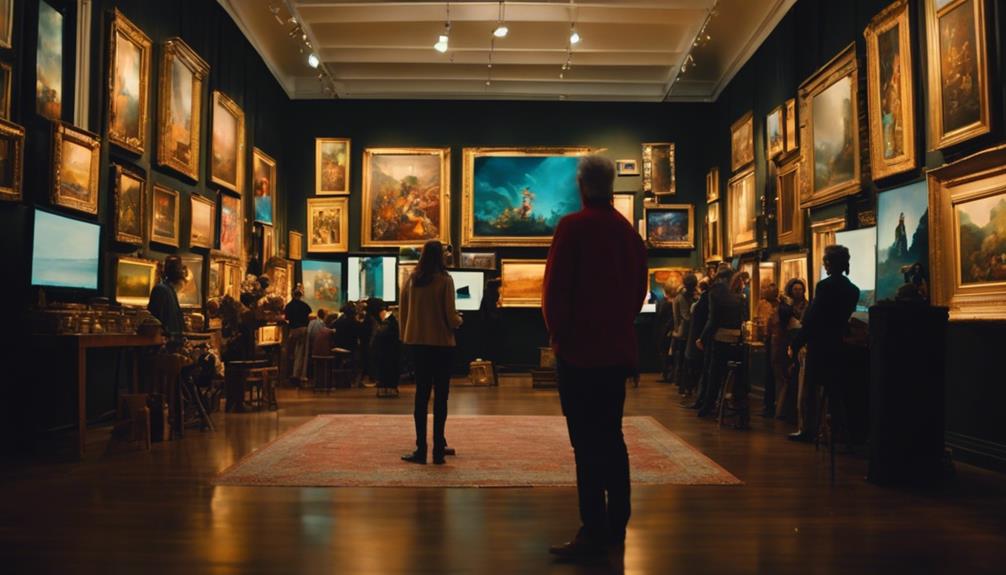
The rise of AI-generated visual art is shaking up how we think about the value of art, creating a bit of a puzzle for collectors and galleries as they enter this new area. The big hurdle here is figuring out if an artwork is the real deal, which is more challenging than before because AI art can be easily made repeatedly and comes from computer algorithms. This situation calls for a fresh look at the game’s rules in the art world, pushing everyone involved to keep up with these tech-driven changes.
In this changing landscape, the art community must find ways to validate artworks’ authenticity and adjust how they decide what art is worth. This evolution is not just about technology; it’s about how we see and value art itself, urging a shift towards new ways of thinking and operating in the art market.
Market Value Conflicts
As AI-generated art becomes more popular, it’s shaking up how we think about who created something and who owns it in the art world. This is making people look again at how much art is worth. The rise of AI in art is not just about who created an artwork but also about whether these artworks are an excellent investment, changing how the market works in significant ways. The more accessible access to art-making through AI challenges the old guard, changing how we see value and what makes something original.
- The growth of AI art is changing old ideas about authorship and ownership in the art scene.
- There are now debates over the value and realness of artworks made by AI.
- As more AI art appears, the usual ways of determining art’s value are being questioned.
- Art collectors and galleries are now looking into AI art to see if it’s a good investment, which is shifting market trends.
- The more accessible access to creating art that AI offers challenges those who are used to controlling the art world, leading to new ideas about what makes art valuable and original.
Authenticity Verification Challenges
Verifying the authenticity of visual art created with artificial intelligence poses real challenges in today’s art scene.
It’s tough to pinpoint who made the artwork or its actual worth because AI art lacks the usual artist’s signature or visible brushwork.
This creates confusion among art lovers and professionals, making it hard to trust the legitimacy of these pieces.
The art world is now forced to look for new ways to check if AI art is genuine.
This shift is crucial for maintaining the value and trust in art made by AI as the industry adapts to these new creative methods.
Future of Artistic Creation
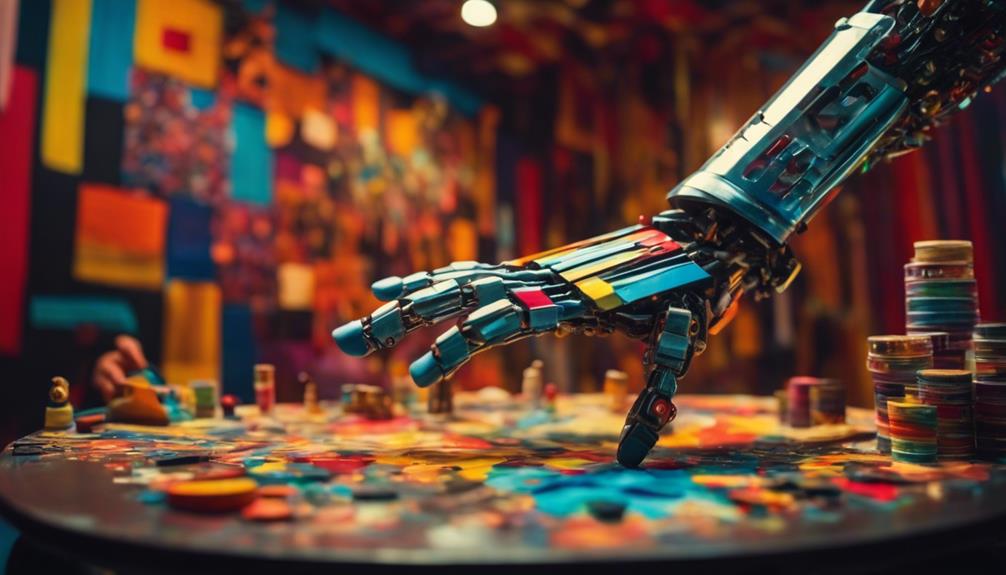
As we look ahead, the intersection of artificial intelligence (AI) and art is reshaping how we think about creativity. This blend of technology and human ingenuity pushes the limits of what’s possible, opening new doors for artistic exploration. AI is not taking over the creative process but is becoming a vital tool that complements the artist’s skill set. This collaboration is creating a fresh landscape for art, where traditional methods merge with cutting-edge technology to forge new forms of expression.
In this new era, artists have more freedom to experiment and push their creative boundaries further. The fusion of AI technology and art is not just about creating new kinds of art but about enhancing the creative process. It enables artists to explore complex concepts and bring their wildest ideas to life precisely and efficiently. This is significant because it means that art can continue to evolve, offering audiences new experiences and perspectives.
Using AI, artists can generate ideas that might not have been possible, making the art world more dynamic and diverse. This technological partnership is proving to be a game-changer, offering a platform for artists to experiment in ways that were unimaginable in the past. It’s a testament to how technology can fuel creativity rather than stifle it, ensuring the future of art is as vibrant and varied as ever.
This shift towards AI-assisted art creation is changing how art is made and how it’s perceived. It challenges us to reconsider our definitions of art and the artist’s role in society. As AI continues to evolve, so will the possibilities for artistic expression, ensuring that the future of art is bright and boundless. The key takeaway here is that when used creatively, technology can amplify human potential, opening up a world of possibilities for artists around the globe.
AI’s Role in Creativity
Introducing Artificial Intelligence (AI) into the artistic world has brought a significant change, altering how we come up with ideas and pushing the limits of artistry. This mix has changed what we think of as creativity by combining the functions of AI with human understanding.
- AI changes the way we create art: With the ability to sift through data and develop ideas quickly, AI tools bring a level of speed and adaptability we haven’t seen before.
- Pushing artistic limits: AI programs create something new, from audiovisual pieces to interactive projects.
- Merging with human creativity: This partnership is shaping the future of art, making it hard to tell apart what’s caused by humans and by AI.
- New developments in art competitions: The involvement of AI in these events is starting a conversation and changing how we express ourselves through art.
- Broadening artistic horizons: AI’s versatility helps artists try different methods and styles, making the creative process more rich and varied.
Artificial Intelligence (AI) stepping into the world of art has been a game-changer, making us rethink how we develop ideas and push artistic limits. This blend reshapes our understanding of creativity by merging AI’s capabilities with human insight.
AI is transforming the art-making process by quickly analyzing data and developing ideas, offering artists unmatched speed and flexibility. AI algorithms can create unique outputs, from audiovisual works to interactive experiences, pushing the boundaries of what we consider possible in art.
This collaboration between human creativity and AI sets the stage for the future of art, where the distinction between artworks created by humans and those generated by AI is increasingly blurred. In art competitions, the presence of AI is sparking debates and changing the ways we express ourselves artistically.
Moreover, AI’s flexibility enables artists to explore various techniques and styles, enriching their creative process. This expansion of artistic horizons makes the art world more diverse and vibrant.
Human-Artist Collaboration Evolution
The collaboration between artists and AI is transforming how art is made. This partnership combines human creativity with the power of technology, leading to new kinds of art that challenge traditional norms. Artists working with AI find themselves exploring paths they might not have considered before, thanks to the technology’s ability to support creative experiments and make the art-making process more efficient. This blend of human insight and the computational skills of AI is creating exciting opportunities for innovative art that could not exist otherwise.
This ongoing evolution in art-making shows how technology and creativity are becoming more intertwined. It’s not just about making art faster or more accessible; it’s about opening up new possibilities for what art can be. As we look to the future, the collaboration between artists and AI will likely keep pushing the boundaries of creativity, leading us into new, unexplored areas of artistic expression. This partnership proves that combining technology with the human touch can create something groundbreaking in the art world.
Public Perception Shifts
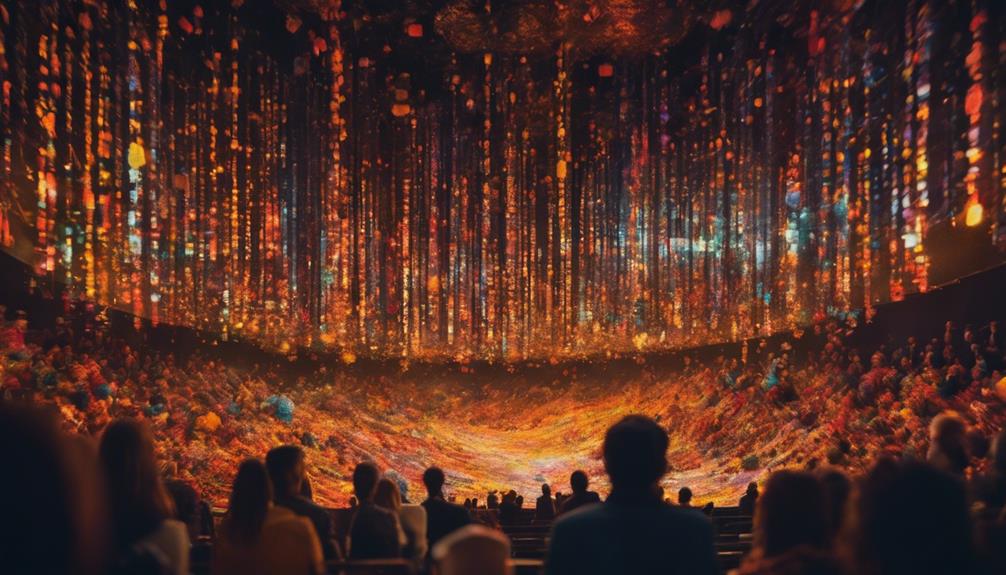
The way people see the role of AI in making visual art is changing. More people now see AI as a helpful partner for human artists. This new view is mainly because people understand that creating art with AI is a team effort. AI helps bring new ideas to life, but the human touch makes the final piece unique.
AI tools are changing how we think about who makes art. People no longer see AI as the only creator. Instead, the teamwork between humans and AI is getting more attention. This teamwork challenges the idea that only one person can be an artist.
The input from humans is vital in making art with AI. This shows how important people are in the creative process. As AI becomes a more accepted tool for making art, how we decide who the artist is is changing, too.
In short, AI is becoming a well-liked helper in the art world. This changes how we see art creation and who gets credit for it.
Frequently Asked Questions
Who Owns Copyright on Ai-Generated Art?
- Copyright laws vary globally, affecting AI art.
- Ownership disputes challenge digital art’s originality.
- Fair use and moral rights complicate registration.
Can You Copyright an AI Generated Image?
- Copyright law challenges shape AI art rights.
- Ethical questions arise around artistic automation.
- Human input is critical in digital creations.
Can Ai-Generated Art Be Detected?
- Signature patterns reveal AI’s art origin.
- Visual tools scrutinize for authenticity.
- Stylistic analysis confirms human or AI creation.
Can an AI Be the Author of a PAInting or the Inventor of a New Product or Process?
- AI’s role in creativity requires assessing ethical and legal aspects.
- Human collaboration is critical to defining ownership in innovations.
- Technology’s limits shape the rights linked to innovative works.
